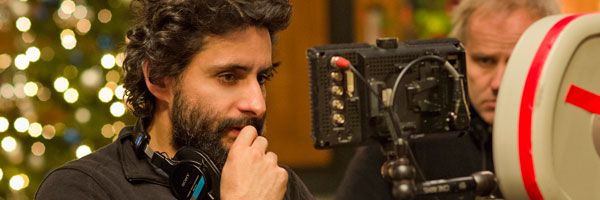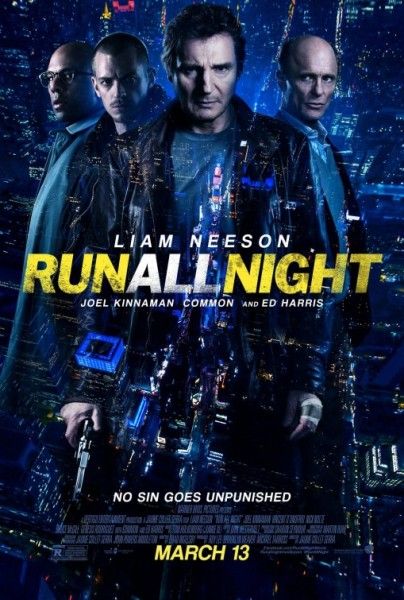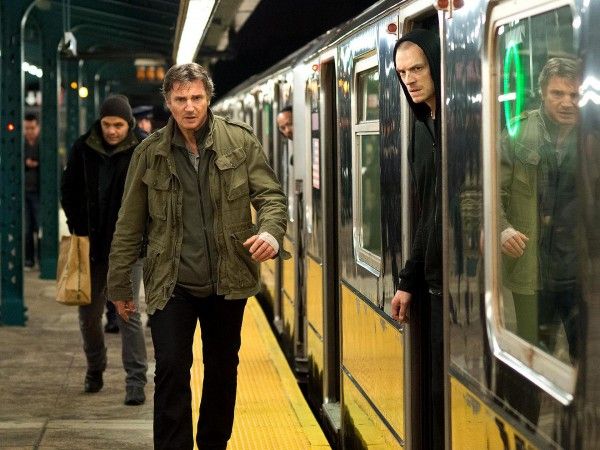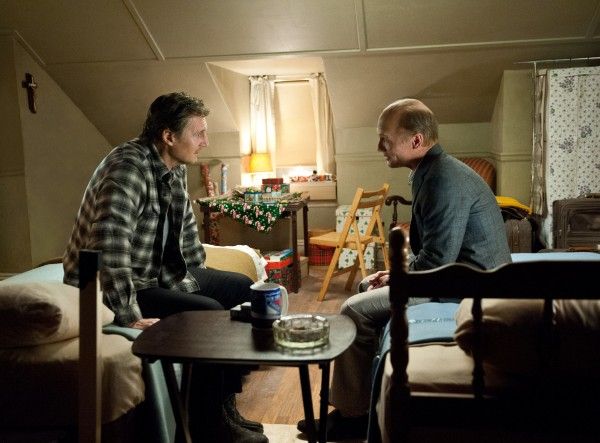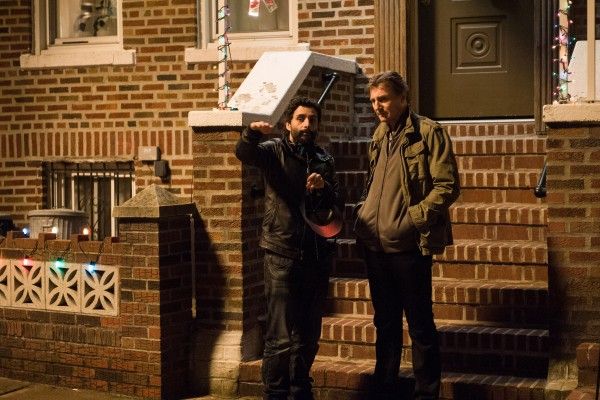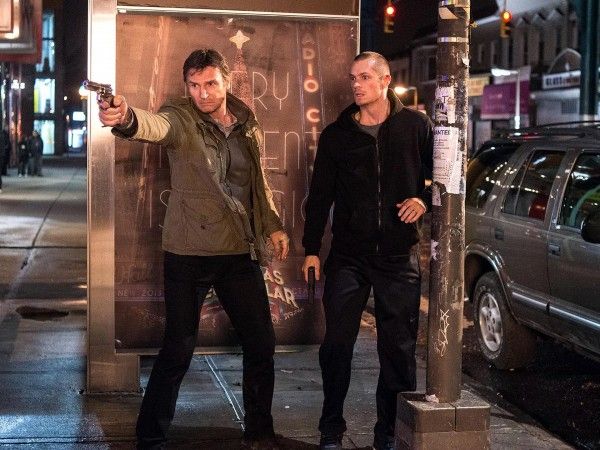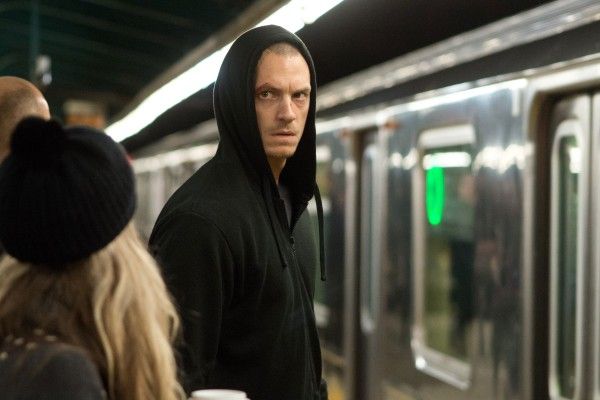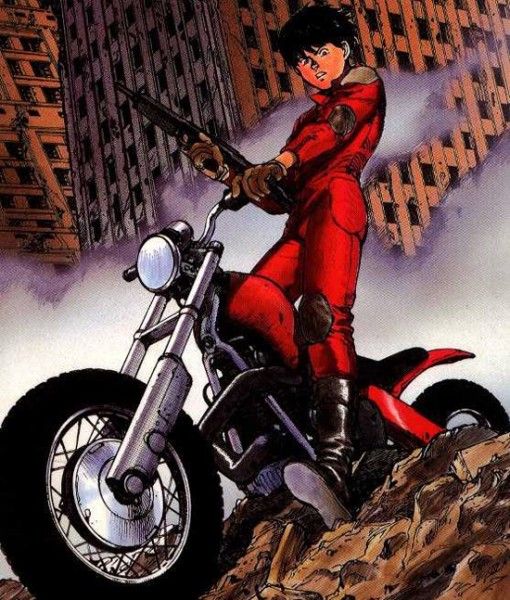It’s only been a year since Non-Stop hit theaters, but director Jaume Collet-Serra is already back with another thriller, Run All Night. Liam Neeson leads as Jimmy Conlon, an infamous hit man dubbed The Gravedigger. But that was back in the day. Now Jimmy’s a washed up drunk with no family and just one friend, mob boss Shawn Maguire (Ed Harris). Shawn’s always had Jimmy’s back and Jimmy’s always been loyal to Shawn in return, but when Jimmy shoots and kills Shawn’s son (Boyd Holbrook) to save his own (Joel Kinnaman), Shawn vows to come after Jimmy with everything he’s got.
With Run All Night hitting theaters nationwide on March 13th, I got the chance to talk to Collet-Serra about his third collaboration with Neeson, pitting him against Common’s more modern/high tech character, shooting an extensive chase scene on a New York subway platform, the status of his live-action adaptation of Akira and more. Check it all out in the interview below.
Question: Last year you told me you break a camera on every film. Did that happen on this one, too?
JAUME COLLET-SERRA: Let me think. Yeah, yeah. We broke one. It fell off the dolly. [Laughs] But camera’s are cheap. It’s the lenses that are expensive, especially these ones because we shot in anamorphic and the lenses are like older than I am.
You didn’t shoot the other films using those lenses, right?
COLLET-SERRA: No. Anamorphic is very difficult because the distance from the lens to the person to focus is very long so you need a lot of distance from the camera to the person so that means that you need a lot of space. Like, it’s hard to do a camera inside of a car. Non-Stop would have been impossible. Usually modern lenses you can focus up to the lens pretty much, but anamorphic you can’t. You need like three feet.
Are they harder to find, too?
COLLET-SERRA: Harder to find, yeah. Now that everyone’s shooting digital they want the anamorphic to soften the look. You know, to make it more filmic.
So you broke a camera, but you didn’t break one of those lenses, right?
COLLET-SERRA: No, no, no. I would have been killed. [Laughs]
I know you did a little script work on Non-Stop. Did this one change much from the original draft you first got?
COLLET-SERRA: No, this one was ready to go. You know, the usual production pass, that’s [what] we call it. Once you find the location you adapt it to the location or things like, I think it was the story was set originally in Philadelphia because the writer is from Philadelphia, so we moved it to New York and it translated seamlessly. And the sports. You know, we obviously used the Rangers and in the script I think it was some basketball stuff, little things like that. The characters, everything was pretty much the same.
So what was it about Jimmy that made you think he could take your collaboration with Liam to the next level?
COLLET-SERRA: Sure, sure. I think that this movie for me was more about the relationship with his son and in the other movies I did with Liam, in Unknown and Non-Stop, they’re very unique situations, short periods of time. In Unknown, the character is confused. In Non-Stop, you have a few hours to resolve a mystery so character kind of gets in the way of the story. You just want to solve the mystery. This one was really character based and relationship based where you get to meet people around this guy’s life. You do not only learn who he is by what he does, but from what people say about him. It’s a story about fathers and sons, which both him and Ed [Harris] are dealing with their sons in a different way. And in this one he had to basically earn the right to be called a father again, so it was more deep and that’s what got to me. It’s more complex in that way and classic, too.
I was reading in the notes that Liam’s character is ex-military. We don’t hear much about that in the film though, so did you do a lot of background work for Jimmy and Shawn?
COLLET-SERRA: Sure, yeah. It’s just that the thing is that we hint at it, but it’s not something that we want to just throw [in] exposition. It was basically based on the reality of a lot of these hitmen in the Westies during the late 70s, early 80s. A lot of them had to come back from Vietnam and had no real skill and they had alcohol issues, but because they had seen what they had seen and done what they had done, they were used by some of the mafias to become hitmen because it was easy - not easy for them, but they already felt that they were lost souls. So then they were given very little money, but for them it was a lot, and they were used. So that’s the kind of character we were talking about. Very few of those ever survived and so we’re almost imagining what happened if those guys would be alive today or not in the witness protection program.
What about how Jimmy and Shawn first met?
COLLET-SERRA: Back then in Hell’s Kitchen, it was literally a very close, tight Irish community so I think all the kids would just hang out outside the clubs where the big boys were trying to make a little money on the side. But when you’re a kid and you see gangsters living the life, you kind of want to be like that. And I think that they definitely come from very poor backgrounds and they want to make it, whatever it takes. Ed’s character is very interesting because somehow he’s smart enough to have made it into a place where he can feel like he’s left that life behind, even though that always comes back to haunt you. It’s impossible to leave that life, even in this case through genetics because his kid wants to be part of that lifestyle.
How about incorporating Common’s character? You generally keep technology in the background, but then Common steps in and he has this next generation spy gear on.
COLLET-SERRA: We wanted to have a character that was like a modern version of what Liam’s character would be so he would have an adversary, a proper adversary. And I think that we approached it from that point of view, somebody that was relentless, ruthless and had all the skills needed. Audiences are used to that. I know it feels like sometimes it’s a character from another movie, but I think that’s fun because if you just had, let’s imagine, another Irish guy, it’s like, ‘Well, of course Liam is gonna beat his ass,’ right? So you almost have to bring somebody from another movie that has an advantage, at least you don’t know what he’s going to do.
Now can you tell me a little bit about those location transitions and what you have to do on-set and then how that links to what you have to do in post-production?
COLLET-SERRA: I have to do nothing on set. [Laughs]
It’s all digital?
COLLET-SERRA: It’s basically still pictures projected on CG shapes. So what we do is we take a shot of the beginning with a normal camera and at the same time they’re taking still pictures of that moment in the direction that we want the shot to begin. So let’s say that the camera supposedly has to freeze and then move this way, so that’s a normal camera and then the still picture’s here, just one here and then maybe one up there to see the overview. Then they come in, they tile everything, they take pictures of the whole environment and then they take pictures from a helicopter of everything and then on the landing they take pictures of everything and then you create the CG shot that links everything together.
Is that something that you have to commit to early on or can you do that in additional photography, maybe after you edit it?
COLLET-SERRA: Additional photography. Yeah, yeah, after. It’s a very small crew. It requires almost no people. It takes a lot of time to do in post-production and it’s very cool. We have this company in France called Buf, they do a lot of shots that are like this. They did Enter the Void and they worked with [David] Fincher on Fight Club and things like that, sort of this virtual photography. We wanted to get a sense of the city and it’s like, ‘In the meantime, this is happening somewhere else.’ We kind of wanted to visualize that and it’s a bit of fun.
As a New Yorker, it’s definitely fun to see stuff like that and it’s also nice to see some convincing geography. I can’t tell you how many times I’ve seen movies set in New York and caught myself thinking, ‘That location shouldn’t really be there.’
COLLET-SERRA: Yeah, we tried. We cheated here and there obviously because we have to. The biggest challenge was to shoot New York in a way that we haven’t maybe seen before, but at the same time be recognized. When I did Unknown and I was in Berlin, I kind of liked how people responded to that movie that I had shot a lot in Berlin and so I wanted to do the same thing here, but obviously a lot more people know New York than Berlin and there was a lot of pressure to do that, but I had the help of many, obviously the local crew. New York is just so perfect for everything. Anamorphic doesn’t really lend itself to the big shots, but we had to figure it out, that’s why there’s a lot of helicopter stuff and a lot of stuff from high up.
How about working with the crowds here? At one point, you put a car through a storefront, so I imagine you must have had a good deal of people watching.
COLLET-SERRA: No, because it was 5am. Nobody wanted to be there. [Laughs] If you shoot at night it’s actually pretty mellow. The first couple of days I remember we were shooting in a neighborhood and we put the big light and like a thousand people showed up. They put chairs on the sidewalks and they sat down and were like, ‘When is Liam showing up?’ I was like, ‘Oh my god, this movie is going to be a nightmare.’ But then it started getting really cold and then people got used to us because we would be in the same location for a long time and then they would just ignore us. Probably one of the most painful places to shoot was that subway.
That’s a big thing I learned in film school here, avoid it because it’s though to get approval.
COLLET-SERRA: They want you to avoid it because they make it very difficult. They have a lot of rules, but there’s nothing like it. It’s amazing to be able to shoot there.
What are some of those rules?
COLLET-SERRA: It has to be a particular station at a particular time, you have from this moment to this moment, obviously you cannot interrupt the traffic or anything, so you’re just dealing with whatever you get. If it’s rush hour and you’re on the platform and a thousand people come on, you have to stop.
Did those restrictions happen to work with the script? Did you have to change day to night or anything like that?
COLLET-SERRA: No, no, I didn’t have to change anything, but it made it very difficult to shoot because you have that scene where Joel Kinnaman is trying to get away, but if in the middle of the shot the subway arrives next to him, I need to cut because he would get on that subway and get away. So I could only shoot when the subway was on the other platform. Little things like that, and the platform is very narrow. It’s not like you can hide if a subway comes so a lot of things happened because of that. Or a thousand people just came and looked straight into the lens like they didn’t expect a movie to be shooting.
Was it like that with the Madison Square Garden scene?
COLLET-SERRA: No, Madison Square Garden is more controlled because we had a real game going and we were around the corner shooting something else and we just set up the cameras and for ten minutes the crowds come out so you just shoot the whole thing in ten minutes. Obviously in the close-ups we bring extras around or we do it later, but them running in and the big shots, they don’t know. They’re just coming out. They might see Liam walking by and they do a double take. You can actually see it in the movie, people looking like this. But that’s very simple because it’s only ten minutes. The hard part on the subway is that you have, let’s say, eight hours, but you have to hit these deadlines. From here to here, you can use this part. From this time to this time, you can use that part, and you have to hit them and it gets very stressful.
Before we wrap up, I need my annual Akira update. Has there been any progress?
COLLET-SERRA: No, no. There’s nothing.
Have you been able to do anything between now and the last time we spoke to get it closer to a green light?
COLLET-SERRA: I’ve shot two movies back-to-back. That’s all I’ve been doing.
So do you know what you’ll jump into next?
COLLET-SERRA: A vacation! I truly will not make a decision on a movie for a few months because I’ve done these two movies in three years without any time off so I cannot wait for this movie to come out and just fade away. So my next movie’s not gonna be for a while, let’s put it this way.
So is there any hope for Akira eventually?
COLLET-SERRA: It’s a Warner Bros. question.

